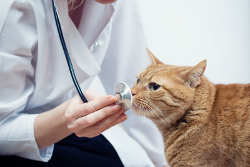Sarcomas are a specific type of cancer. They present as a subcutaneous (beneath the skin) lump and are malignant tumors arising from transformed cells.
Vaccine-Associated Sarcomas (VAS)
In 1991, veterinarians began noticing a larger number of sarcomas developing on the body of cats under care. This was around the time when new vaccines were introduced and administered routinely. The elevated cases of sarcomas coincided with the transition from using modified-live rabies vaccines to adjuvanted killed virus vaccines. Adjuvants are immunological compounds that enhance the immune system’s response to an antigen. Aluminum-adjuvanted feline leukemia (FeLV) vaccines were introduced around the same time as well.
The sarcomas often formed in common vaccination sites. These sites include:
- Between the shoulder blades
- The hip region
- Hindlimbs
A relationship was soon established between these tumors and vaccines such as rabies and FeLV. It is now believed that certain cats have a predisposition to develop these tumors. The genetic factor in this predisposition has not yet been determined.
So, What Is Being Done?
Fortunately, vaccine-associated sarcomas are rare. Even so, vaccine manufacturers are developing new versions of the vaccines with alternate adjuvants. Also, a group has since been established to research the issue. The Vaccine-Associated Feline Sarcoma Task Force is an alliance of veterinary organizations dedicated to studying and remedying this problem.
What You Can Do
It’s important to know that the risk of not vaccinating your cat far outweighs the possibility of her developing a vaccine-associated sarcoma. Therefore, it is vital that all necessary vaccinations are administered for the health and safety of your cat.
Be Informed
Your veterinarian will establish a vaccination schedule based on your cat’s individual risks. Any unnecessary vaccinations will be avoided while ensuring your cat’s optimal safety and future health. A three-year rabies vaccine will suffice for an indoor cat, while cats that are let outdoors may require an annual vaccination.
Ask Questions
Inquire about the rabies vaccine that is available. Is it a modified-live rabies or an adjuvanted killed virus vaccine?
What to Look For
Following a routine vaccination, it is common for a small lump to present at the injection site. This is a result of the body’s initial response to the vaccine which causes minor swelling under the skin. The lump can last a few days to a month. If it persists beyond a month’s time, then it is best to return to your veterinarian.
Diagnosis
A sarcoma is diagnosed by a biopsy of the tissue. Upon a confirmed diagnosis, additional tests are performed to determine the cat’s overall health and also to determine if the tumor cells have metastasized (spread to other parts of the body). Some of these tests may include:
- A complete blood count (CBC)
- Urinalysis (U/A)
- Sonogram or other radiology
- Serum biochemistry panel
- Thoracic radiographs
- Lymph node aspiration
Treatment Options
A treatment plan is devised based on a number of factors, such as:
- Results of the above tests
- Location and size of the tumor
- Wishes of the cat’s owner
Surgery
Generally, the first option in the treatment of a sarcoma is surgery to excise the mass. If the tumor is small enough and/or in a location where adequately wide margins can be achieved, surgery is considered the treatment of choice.
Surgery and Radiation
In cases where clean margins can not be achieved due to the location and/or size of the tumor, a combination of surgery to excise the bulk and radiation therapy has proven to decrease the risk of recurrence. A CT scan is done prior to radiation in order to assist the veterinary oncologist with planning the most effective treatment.
The goal is to optimize the destruction of the tumor cells but also minimize the impact on healthy tissue and surrounding organs. Radiation therapy consists of several (15-20) treatments that are given on a Monday through Friday schedule. Despite the grueling schedule, radiation therapy is well tolerated by cats and side effects are mild. Rapidly dividing tissue such as skin and hair may experience some reversible reactions.
Chemotherapy
Another treatment option is chemotherapy. It is usually chosen to treat tumors with a higher likelihood of metastasis but can also be used as an effective method to target cancer cells in cats with vaccine-associated sarcomas. Chemotherapy consists of four to six treatments given at three-week intervals.
The drugs work by targeting and destroying rapidly growing cells, which is the way cancer cells behave. Thus, chemotherapy spares normal, healthy tissue. Potential does exist for some normal cells that naturally grow and divide rapidly to be inadvertently damaged. These include:
- Hair cells
- Intestinal lining
- Bone marrow
The doses used are much lower than the doses used to treat people. Toxicity is rare but side effects may occur. The oncologist will advise the owner of any possible side effects based on all factors of the individual case and explain what to keep an eye out for.
There is always a risk when a drug is introduced into the system for the first time. If the cat experiences any side effects, the dose is adjusted to ensure quality of life during treatment. The drug administered during chemotherapy is called doxorubicin, and a side effect unique to this drug is a weakening of the kidneys from multiple doses. Blood tests will be performed periodically to monitor for this.
Palliative Radiation Therapy
Finally, if none of the above options can be utilized to successfully treat the sarcoma or if distant metastasis is observed, palliative radiation therapy is an option to make the cat comfortable. This treatment consists of two consecutive doses, twice daily. It’s aimed at relieving the inflammation and pain resulting from the tumor. The treatment is often repeated after one month in order to extend the duration of the response if no progression of the cancer is observed.
If you think your cats is showing any of the symptoms discussed in this article you should take your pet to your veterinarian as soon as possible. Your vet will be able to provide you with the best options for your pet.
Thanks for visiting www.catdandruffclinic.com, if you liked this article please like us using the side bar .
Related Posts:



Comments are closed.